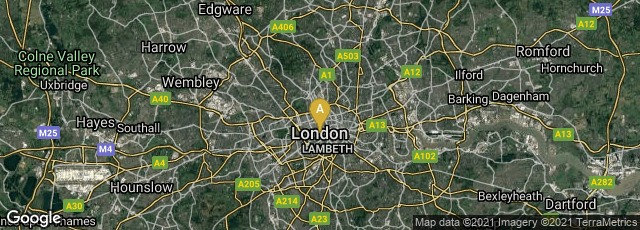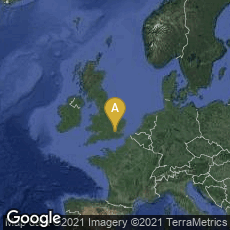

A: London, England, United Kingdom
The first ever sheets printed by Koenig's cylinder flat-bed press that were actually issued were sheets G (pp. 81-96) and X (pp. 305-20) of Thomas Clarkson's Memoirs of the Private and Public Life of William Penn, Vol. 1 [1813] printed by Koenig's sponsor, printer Richard Taylor, at his press in Shoe-Lane, London. This is a photograph of a copy in the original boards with margins showing the deckle edge of the handmade paper before it was cut by a binder's knife.
On October 30, 1811 printer and inventor Friedrich Koenig received his second British patent No. 3496 for "Further Improvements on my Method of Printing by Means of Machinery," describing the first cylinder flat-bed press.
"This steam-driven machine, revolutionary though it was, still incorporated vestiges of the hand press, as certain developments necessary to transform the printing press completely had not yet taken place. The forme no longer made a simple movement under a platen, rather the bed on which it was fastened received a continual motion by means of a double rack—for every sheet it moved to and fro.
"The platen was discarded in favour of a 'pressing cylinder,', which was completely novel. Koenig, writing later in The Times of 8 December 1814, explained the difference between the earlier cylinders and his invention: 'Impressions produced by means of cylinders, which had likewise been already attempted by others, without the desired effect, were again tried by me upon a new plan, namely, to place the sheet round the cylinder, thereby making it, as it were, part of the periphery.' Koenig's machine was, therefore not a mangle, in which a sheet is rolled and pressed, which was the essence of earlier ideas, and of some yet to come, but an ingenious device for bringing the sheet of paper rapidly to the point of impression.
"In the absence of grippers, a continuous motion to Koenig's cylinder would not have allowed the feeding of sheets, so there had to be an intermittent or stop motion. The cylinder was therefore divided into three parts, which were covered with cloth and provided with points in the manner of tympan on a hand press' and iron frames, which continued to bear the name of 'friskets', were attached to hold the sheets of paper. The surface of the cylinder between the 'tympans' was cut away to allow the forme to pass freely under it on its return. The cylinder made one-third of a revolution for each impression and then stopped. The sequence was as follows: the uppermost frisket seized a sheet of paper and moved into the next position; the sheet formerly in that position came into contact with the forme and was printed; the third segment moved to the upper position.
"Composition rollers were in their infancy, and at this point Koenig utilized once again leather-covered rollers, which were not very efficient, and it was also difficult to supply them with an even flow of ink. The ink-box consisted of a vertical cylinder with a hole at the base, about half an inch in diameter, and was fitted with an air-tight piston, which was depressed by a screw which forced the ink out on the rollers. Whatever the drawbacks of this machine, it was set to work at the rate of 800 impressions an hour" (Moran, Printing Presses [1973] 106).
♦ The first ever sheets printed by Koenig's cylinder flat-bed press that were actually issued were sheets G (pp. 81-96) and X (pp. 305-20) of Thomas Clarkson's Memoirs of the Private and Public Life of William Penn, Vol. 1 [1813] printed by Koenig's sponsor, printer Richard Taylor, at his press in Shoe-Lane, London. Comparison of the inking between the gatherings printed on Koenig's machine and those printed on the hand press shows subtle differences. A copy of this volume in the original boards, uncut, contains advertisements for Longman publications "Corrected to March 1813", suggesting that this book was issued in March or April of that year.
Koenig's third British patent, no. 3725, for "Certain Additional Improvements in my Method of Printing by Means of Machinery," issued on July 23, 1813
"contained improvements on that of 1811 and served as the basis of the double machine. For this a second cylinder was added by which the return movment of the bed was made productive. While the printer cylinders were divided into three parts as before, each being covered with cloth with points attached, the 'friskets' were abolished in favour of endless tapes conducted over rolls. The ink system underwent modifcation to the demands of double printing. The inking rollers were set transversely across the forme with their axles meeting on one side. In the patent the inking rollers were still described as covered in skin, but Koenig learned of the superiority of composition rollers during the year, otherwise The Times machine could not have worked as effectively as it did" (Moran, op. cit. [1973] 107).
Koenig's last English patent, No. 3868, "Certain further improvements on my method of printing by means of machinery," granted on December 24, 1814, was the basis of an improved cylinder machine and of a perfecting machine—one which would print on both sides of a sheet of paper.
♦ The first detailed English language historical account of Koenig's development of the steam or machine press was written by Samuel Smiles and published in Macmillan's Magazine, December, 1869 as "Friedrich Koenig: Inventor of the Steam-Printing Machine." Smiles expanded this article and reissued it as Chapter 6 of his Men of Invention and Industry (1884).